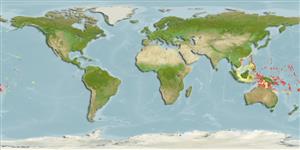Environment: milieu / climate zone / depth range / distribution range
Écologie
marin récifal; profondeur 0 - 38 m (Ref. 90102), usually 0 - 15 m (Ref. 90102). Tropical
Pacific Ocean: Micronesia, Indonesia, New Guinea, Solomons, Vanuatu Is., Fiji, Samoa, and Australia.
Taille / Poids / Âge
Maturity: Lm ? range ? - ? cm
Max length : 14.9 cm TL mâle / non sexé; (Ref. 57884); 13.2 cm SL (female)
Description synthétique
Clés d'identification | Morphologie | Morphométrie
Rayons mous dorsaux (Total) : 84 - 91; Rayons mous anaux: 65 - 74; Vertèbres: 44 - 46. Diagnosis: Vertebrae 11+33-35=44-46, dorsal fin rays 84-91, anal fin rays 65-74; eyes large (2.6-3.5% SL); outer pseudoclasper massive, hook-shaped, very broad in ventral view; inner pseudoclasper stout, fleshy, not extending over anterior rim of outer pseudoclasper; broad scale patch on cheek, large scale patch on operculum continuous above and below opercular spine (Ref. 57884).
Maximum length of 14.9 cm TL. Solitary inhabitant of coral reef crevices, cryptic (Ref 90102). Maximum length for female 13.2 SL (Ref 57884).
Life cycle and mating behavior
Maturities | Reproduction | Spawnings | Egg(s) | Fecundities | Larves
Schwarzhans, W., P.R. Møller and J.G. Nielsen, 2005. Review of the Dinematichthyini (Teleostei, Bythitidae) of the Indo-West-Pacific. Part I. Diancistrus and two new genera with 26 new species. The Beagle, Records of the Museum and Art Galleries of the Northern Territory 21:73-163. (Ref. 57884)
Statut dans la liste rouge de l'IUCN (Ref. 130435)
Menace pour l'homme
Harmless
Utilisations par l'homme
Pêcheries: sans intérêt
Outils
Articles particuliers
Télécharger en XML
Sources Internet
Estimates based on models
Preferred temperature (Ref.
123201): 26.4 - 29.3, mean 28.6 °C (based on 1326 cells).
Phylogenetic diversity index (Ref.
82804): PD
50 = 0.5000 [Uniqueness, from 0.5 = low to 2.0 = high].
Bayesian length-weight: a=0.00389 (0.00180 - 0.00842), b=3.12 (2.94 - 3.30), in cm total length, based on all LWR estimates for this body shape (Ref.
93245).
Niveau trophique (Ref.
69278): 3.4 ±0.6 se; based on size and trophs of closest relatives
Fishing Vulnerability (Ref.
59153): Low vulnerability (10 of 100).
